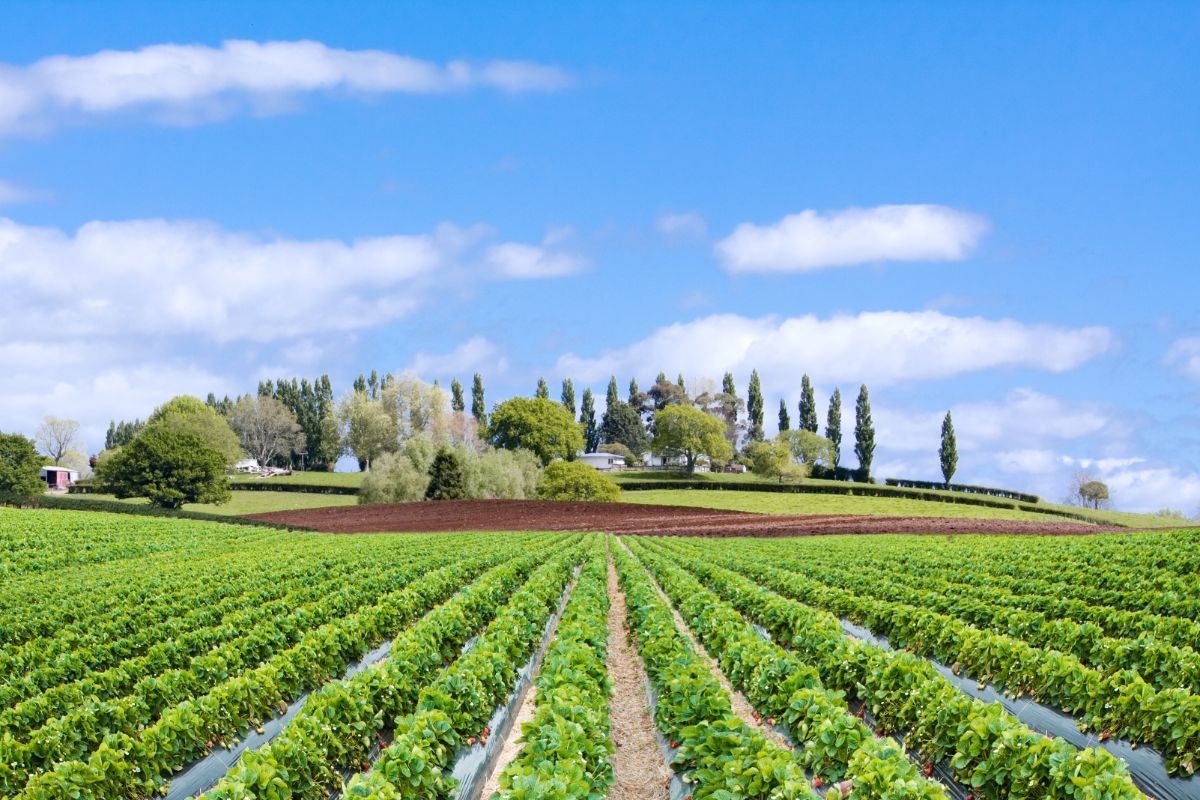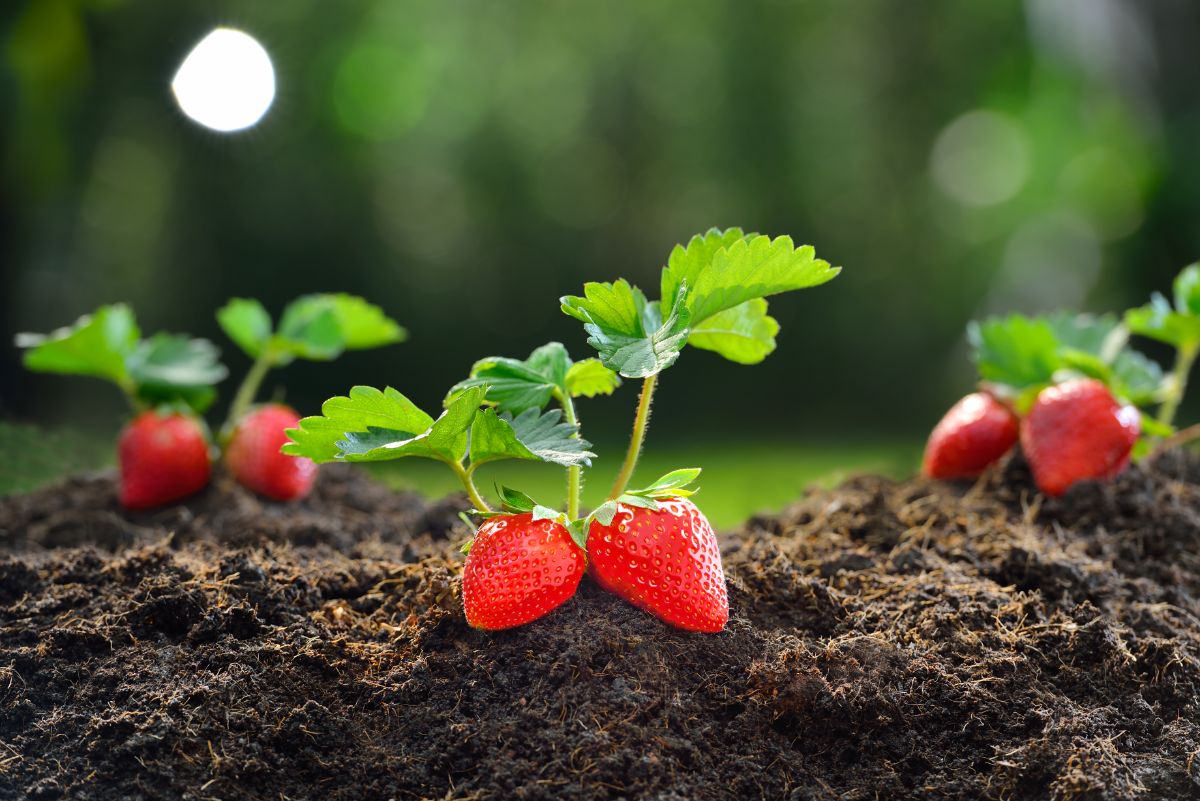Strawberry plants can be a little finicky when it comes to their real estate. It is extremely important for any new strawberry grower to identify the best location for strawberry plants among the potential sites. If the location is poorly suited for growing strawberries, you won’t reap a big harvest of plump, juicy fruit. But, fear not! This guide will help you locate and identify the best location for strawberry plants among the sites you are considering.
Jump to:
Best Location for Strawberry Plants: Checklist
Site Topography

Strawberry plants need drainage. If planted in a naturally-formed bowl or low spot in the ground, both air and water will have difficulty draining away from your strawberry planting. The absolute best location for strawberry plants will have a slight slope to the land. The ideal grade for a strawberry planting is 5% to 7%. However, anything up to 12% is permissible. Plantings that have a slope less than 5% will result in stagnant air and water. Such plants will suffer a higher rate of failure due to the pooling of water and stagnant air. Both encourage the formation of fungal infections that can permanently damage or outright kill your strawberry plants.
A grade over 12% will introduce other complications. The best location for strawberry plants will have a grade less than 12% because a slope steeper than 12% will cause tillage difficulties and promote erosion and soil quality degradation. While not absolutely contraindicated, plantings on steep locations should be avoided. If absolutely necessary due to the lack of more ideal spots, some of the drawbacks of steep slope plantings can be mitigated by spacing the rows more widely and planting them either with the contours or across the slope.
Site History
When deciding upon the best location for strawberry plants, it is important to factor in the history of the locations being considered. If certain plants or crops have preceded a strawberry planting, it can be devastating to a strawberry planting. For more on these crops, refer to Companion Planting Strawberries article. Additionally, if strawberries themselves have been planted in the same location you intend to re-plant with strawberries, a lower yield and poorer plant standards can be expected.
Soil Composition

Fortunately, strawberry plants are fairly adaptable. They can perform well in many soil types. The ideal location will be a deep, fertile soil. It will have good internal drainage (to prevent root rot and other problems associated with excess or standing water). The soil will not be compacted, and it will be high in organic matter. Additional organic matter can be added, however. Amending the soil with aged manure will boost production in soil locations lacking optimal levels or organic material.
Best Location for Strawberry Plants: Conclusion
Before planting, it will pay dividends to find the best location for strawberry plants among your available options. Higher yields, happier plants, and a heaping harvest of healthy strawberries can be yours! Be sure to review all the other necessary information about the process here: Growing Strawberries. Learn about the types of strawberries here: Strawberry Varieties. And, good luck!










Ken Pischel says
Hello Mr. Strawberry,
First-time strawberry grower with my new purchase of roots temporarily planted in my vegetable garden until I construct my mound and rows suitable for transplant. By the way, my root plants, which have been in the ground for two weeks are thriving. My concern is the construction of the mounded rows. I have observed commercial growers use these raised mounds vice level to the ground (probably for drainage – but may need more watering?). Should I use another technique and what soil composition should I use? This is what I have accomplished so far
— Roto-tilled existing lawn (no other prior plants/crops) to a depth of 6″.
The soil is clay composition but not hard-packed.
And this is my plan and questions- please give me a sanity check.
1. Purchase ‘Tilling Compost’ – lay down 3″ layer and roto-till into the 6″ prepared area. Or, should I acquire a mixture of Top Soil/Compost and lay down 6-10″?
2. Form mounded rows about 6-8″ high and 3′ apart.
3. Use weed-blocking material to cover mounds and secure with pegs.
4. Transplant each plant from the garden to a hole treated with berry fertilizer in the material so that crown is above the soil line.
Sir, am I missing anything or would you change this mission? Any suggestions or comments would be greatly appreciated.
Many Thanks.
>> Ken
Mary Ward says
This is a pretty good plan. I would only make two foot aisles, not three, unless there is a different reason you want them spaced so far apart (like to get a mower or something in between). Two feet is usually plenty and doesn’t waste space. I don’t know if you are growing everbearing or June-bearing varieties, but with the weed barrier, if you are growing June bearing you will want to make some small holes for the new runners to root and spread.
Alex says
The plot for our strawberry plants is on a west facing slope of about 10%. For matted rows, should they run with the slope or perpendicular?
Mary Ward says
Since they are not tall plants and won’t cast much shade, it probably won’t make a huge difference. Whichever layout gives you the most exposure to the longest sunlight on the most plants. That said, I would be inclined to run them with the slope.
Terri says
my strawberries grow like a weed get flowers but no berries. They were at the house we bought.This is my 3rd summer with them & yes I have seen bees on them.
Ethan Meadows says
get good at growing berries kid.